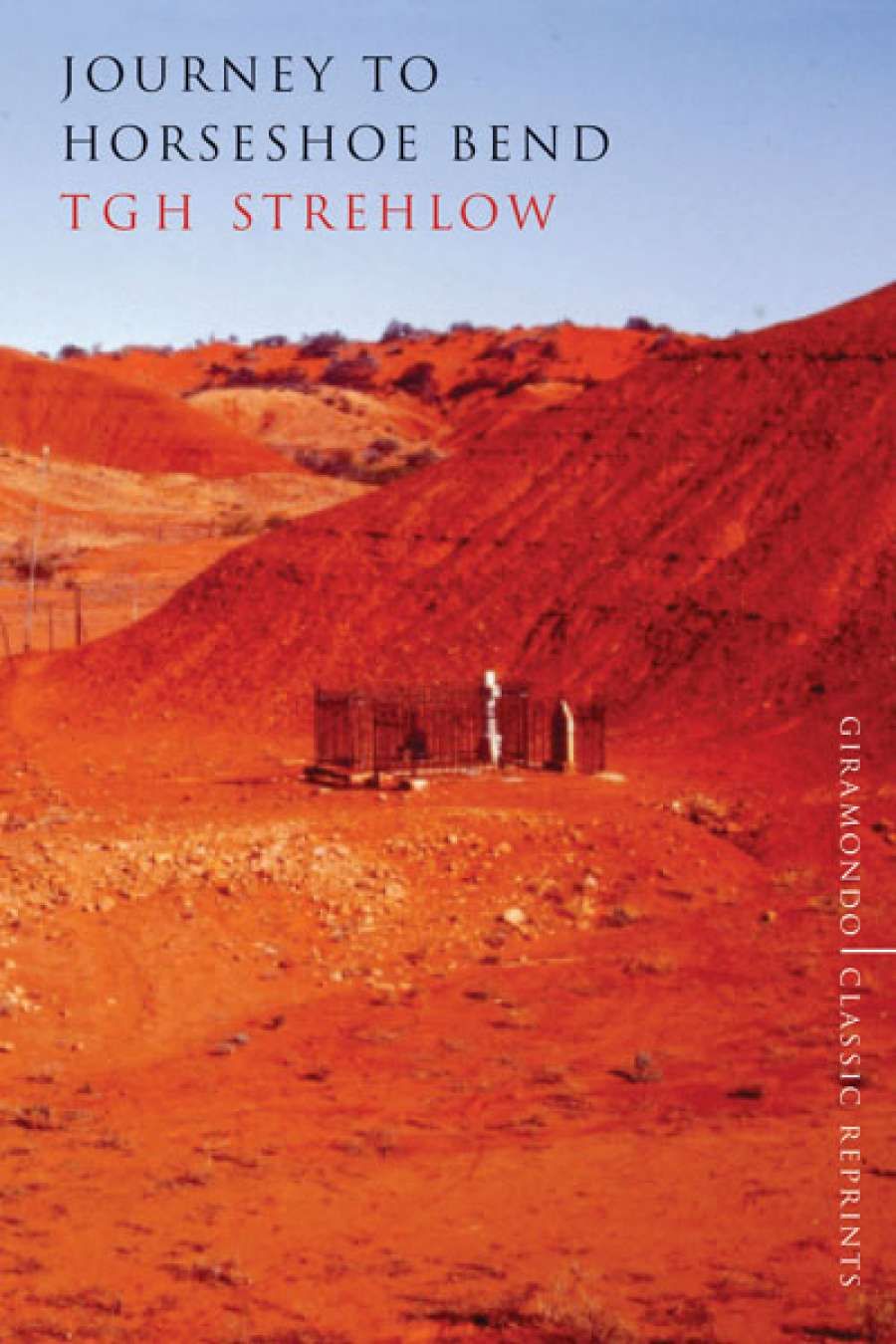
- Free Article: No
- Contents Category: Memoir
- Custom Article Title: Simon Caterson reviews 'Journey to Horseshoe Bend' by T.G.H. Strehlow
- Review Article: Yes
- Online Only: No
- Book 1 Title: Journey to Horseshoe Bend
- Book 1 Biblio: Giramondo Publishing, $26.95 pb, 352 pp, 9791922146779
T.G.H. Strehlow grew up among the Arrente, on whose land the mission at Hermannsburg was established. He absorbed the language and culture, and can be viewed as a man of two worlds – or three worlds if you divide the Western part of his background into German and Australian. Strehlow's evocation of the desert landscape and climate is shaped by his understanding of a mythological topography as immutable as the beautifully described physical features: 'Nature showed a resourcefulness in the Centre that mere man could only marvel at.'
The fact that the events described in the book took place in the 1920s is accompanied by a modernist sensibility, which allows for authorial innovation. Strehlow features his own fourteen-year-old boyhood self in the story in the form of a character named Theo, while a third-person omniscient narrator accesses freely the inner thoughts and feelings of the other characters, notably the author's dying father. If nothing else, Journey to Horseshoe Bend is an impressive exercise in what is termed creative non-fiction.
Journey is rich in social commentary as well as cultural knowledge. Viewed in terms of the factual content alone, the book is undoubtedly a valuable historical account of life in Central Australia at the time when traditional Aboriginal society was being destabilised due to the encroachment of the white settlers.
Strehlow empathises with everyone involved, pointing out how harsh life was for the whites who were operating at the limits of their physical capacity. His sympathies, however, lie mostly with the indigenous people, who are not encumbered by the greed, hypocrisy, and racism of some of the whites. While the Aborigines do not reject anyone because of the colour of their skin, the settlers have developed a kind of creole grading system based on fractions that determine a person's acceptability.
Journey moreover provides a vivid insight into the asceticism of Lutheran theology and, more generally, the vital role played by Christianity in the European settlement of Australia. Some of the most moving passages in the book describe the dying Carl Strehlow's physical torment, during which his rational mind stays alert. Strehlow imagines his father wanting to engage critically with God over the nature of his suffering while realising that any such argument is futile, and that he must simply summon the resolve to submit to God's will. Carl Strehlow was just fifty when suddenly struck down by the dropsy that killed him towards the end of the journey.
'Journey is rich in social commentary as well as cultural knowledge'
Journey is full of wonders and is one of those books that should never be out of print. It represents a massive feat of autobiographical and anthropological prose, but is it a literary masterpiece? The crucial question here is whether or not the subjective and objective elements gel – I am in two minds about that.
Journey is not an artistic failure by any means, although the singularity of its conception can perhaps be viewed as a constraint as well as a strength. Graham Greene famously claimed that every great writer must have a chip of ice in his or her heart. With Strehlow, it can seem as though the chip exerting the most influence on the story of his father's last illness is the one on his shoulder.
 Hermannsburg, Northern Territory (photograph by Alessandro via Wikimedia Commons)
Hermannsburg, Northern Territory (photograph by Alessandro via Wikimedia Commons)
'Journey is full of wonders and is one of those books that should never be out of print'
As Philip Jones, a leading authority on Strehlow's life and work, relates in the afterword to this fine edition, throughout his life Strehlow believed his father had been severely mistreated, effectively condemned to premature death by the careless attitude of the Lutheran hierarchy. During his own career as an academic linguist and anthropologist, Strehlow apparently displayed a tendency to quarrel with those colleagues and institutional patrons who challenged his will. Home-schooled at the remote desert mission, the adult Strehlow doesn't seem to have quite fitted in with the wider Australian society. He may have struggled to empathise with the views of other people whose intellectual interests overlapped with his own but whose knowledge and understanding he would have regarded, not without justification, as inferior.
It could be that external factors such as the crass anti-German sentiment in Australia occasioned by World War II played a part in the underlying alienation of Strehlow, compounded by the natural aloofness and proneness to paranoia of the autodidact. In any case, Jones writes that Strehlow did not respond warmly to editorial suggestions for changes in his manuscript.
In Journey, ultimately it is the depth of Strehlow's literary imagination that in the reading impresses most rather than the range. But what an imagination the author must have possessed to have produced Journey to Horseshoe Bend, a memoir like no other.


Comments powered by CComment